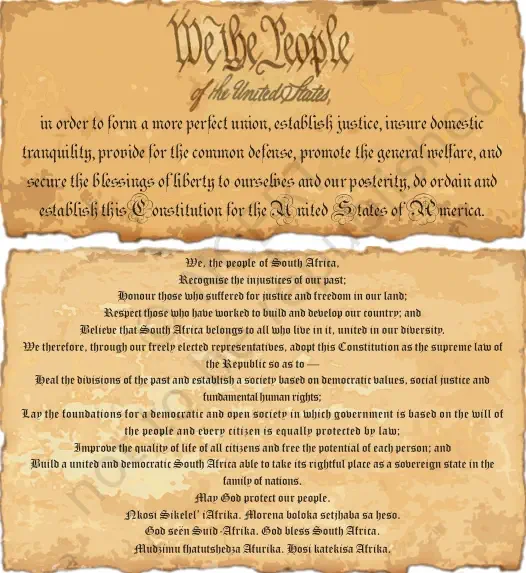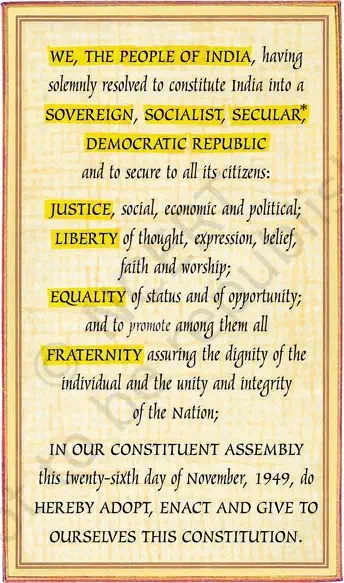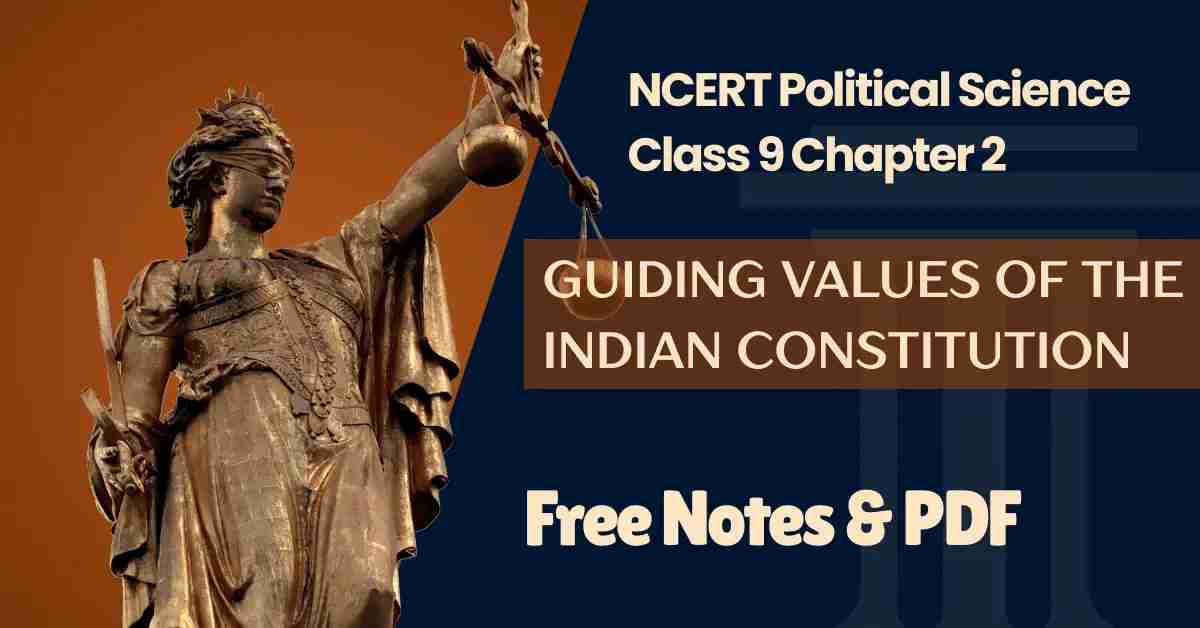Guiding Values Of The Indian Constitution – Concept & Notes PDF
Topic covered: Guiding Values Of The Indian Constitution class 9 notes and MCQs Questions: Constitutional Design (All single detail notes are exam-oriented).
We have discussed in-depth and exam-oriented pointers that can be asked in the board exam of class 9th about the “Guiding Values Of The Indian Constitution“ from the NCERT Political Science (Civics) notes for class 9th chapter 2 Constitutional Design.
Download the NCERT Political Science (Civics) for Class 9th Chapter 2 Constitutional Design Notes PDF
Chapter 2: Constitutional Design in Class 9 Political Science explains how a constitution is created and why it is essential for a democracy. It uses the story of South Africa’s struggle against apartheid to show how rules and principles shape equality and justice. Students often get confused with terms like “assembly” or “sovereignty,” so these notes simplify them with clear explanations. Important ideas such as fundamental rights, guiding values, and the purpose of the Preamble are highlighted in an easy-to-follow manner. Download the NCERT Political Science (Civics) for Class 9th Chapter 2 Constitutional Design Notes PDF to revise effectively.
Guiding Values Of The Indian Constitution
- The book will explain the exact provisions of the Indian Constitution on different subjects.
- At this stage, the focus is on understanding the overall philosophy of the Constitution.
- The philosophy of the Constitution can be understood in two ways:
- By reading the views of major leaders on the Constitution.
- By reading what the Constitution itself says about its philosophy.
- The Preamble to the Constitution expresses its own philosophy.
- Both leaders’ views and the Preamble are essential to understand the philosophy of the Constitution.
The Dream and The Promise
1. Mahatma Gandhi’s role and vision:
- Gandhi was not a member of the Constituent Assembly.
- Many members of the Assembly followed his vision.
- In Young India (1931), Gandhi expressed what he wanted the Constitution to achieve.
- His dream:
- Release India from thralldom and patronage.
- Make the poorest feel ownership of the country.
- Abolish high and low classes in society.
- Ensure harmony among all communities.
- End untouchability.
- Remove intoxicating drinks and drugs.
- Guarantee equal rights for women and men.
- Gandhi would be satisfied with nothing less than this vision.
2. Dr. B. R. Ambedkar’s concern:
- Shared Gandhi’s dream of eliminating inequality.
- Had a different understanding of how to remove inequalities.
- Criticised Gandhi’s vision at times.
- In his concluding speech to the Constituent Assembly, Ambedkar highlighted a major contradiction:
- Political equality: one person, one vote, one value.
- Social and economic inequality: continued denial of equality due to social and economic structure.
- Warned that if social and economic inequality persisted, political democracy would be in danger.
3. Jawaharlal Nehru’s midnight speech (15 August 1947):
- Famous speech to the Constituent Assembly at the stroke of midnight.
- Declared that India was redeeming its tryst with destiny.
- Marked the historic moment: India awake to life and freedom.
- Described it as a rare moment when:
- An age ends and a new age begins.
- The soul of the nation finds expression after long suppression.
- Emphasised responsibility of the sovereign Assembly representing sovereign people.
- Stressed that freedom brings responsibility to serve the people.
- Called for dedication to:
- Service of India and her people.
- The larger cause of humanity.
- Acknowledged the pains of labour in freedom’s birth but urged focus on the future.
- Saw the future as one of striving, not ease or rest.
- Service of India meant:
- Ending poverty, ignorance, disease, and inequality of opportunity.
- Quoted Gandhi’s ambition: to wipe every tear from every eye.
- Concluded that as long as there is suffering and tears, India’s work will not be over.
Philosophy of The Constitution

1. Foundation of the Constitution:
- Values from the freedom struggle laid the foundation for Indian democracy.
- These values are embedded in the Preamble.
- The Preamble guides all articles of the Constitution.
- Constitution begins with a short statement of basic values, called the Preamble.
- Inspired by the American model, most modern constitutions also begin with a Preamble.
2. Importance of the Preamble:
- The Preamble should be read carefully to understand its key words.
- It is described as a poem on democracy.
- It contains the philosophy of the Constitution.
- Acts as a standard to judge laws and government actions as good or bad.
- Known as the soul of the Indian Constitution.
3. Key Principles in the Preamble:

- We, the People of India
- Constitution made by the people through their representatives.
- Not given by a king or any external authority.
- Sovereign
- People have the supreme right to make decisions on internal and external matters.
- No external power can dictate to India.
- Socialist
- Wealth is generated socially and must be shared equally.
- Government should regulate land and industry to reduce socio-economic inequalities.
- Secular
- Citizens have freedom to follow any religion.
- No official religion in India.
- Government treats all religions equally.
- Democratic
- People enjoy equal political rights.
- People elect their rulers and hold them accountable.
- Government functions according to basic rules.
- Republic
- The head of state is elected, not hereditary.
- Justice
- No discrimination on caste, religion, or gender.
- Social inequalities must be reduced.
- Government must work for the welfare of all, especially disadvantaged groups.
- Liberty
- No unreasonable restrictions on thinking, expressing, or acting on thoughts.
- Equality
- Everyone is equal before the law.
- Traditional social inequalities must end.
- Equal opportunity must be ensured for all.
- Fraternity
- All citizens should act like members of one family.
- No one should treat another citizen as inferior.
Institutional Design
1. Nature of the Constitution:
- A constitution is not only a statement of values and philosophy.
- It mainly embodies values into institutional arrangements.
- Much of the Indian Constitution deals with institutional arrangements.
2. Features of the Indian Constitution:
- It is a long and detailed document.
- Needs to be amended regularly to stay updated.
- The framers wanted it to match people’s aspirations and societal changes.
- It was not seen as a sacred, static, or unalterable law.
3. Constitutional Amendments:
- The Constitution has provisions for changes from time to time.
- Such changes are called Constitutional Amendments.
4. Language and Understanding:
- The Constitution is written in legal language, which is hard to understand at first.
- However, its basic institutional design is not difficult to understand.
5. Basic Institutional Design:
- Provides a procedure for choosing persons to govern the country.
- Defines distribution of power for decision-making.
- Puts limits on government power by granting rights to citizens that cannot be violated.
6. Scope of Study:
- The next three chapters will cover:
- Procedure of choosing representatives.
- Distribution of powers and decision-making.
- Rights of citizens.
- Not all salient features of institutional design are covered in this book.
- Some features will be studied in the next year’s textbook.
Key Terms and Definitions
- Apartheid: The official policy of racial separation and ill treatment of blacks followed by the government of South Africa between 1948 and 1989.
- Clause: A distinct section of a document.
- Constituent Assembly: An assembly of people’s representatives that writes a constitution for a country.
- Constitution: Supreme law of a country, containing fundamental rules governing the politics and society in a country.
- Constitutional amendment: A change in the constitution made by the supreme legislative body in a country.
- Draft: A preliminary version of a legal document.
- Philosophy: The most fundamental principles underlying one’s thoughts and actions.
- Preamble: An introductory statement in a constitution which states the reasons and guiding values of the constitution.
- Treason: The offence of attempting to overthrow the government of the state to which the offender owes allegiance.
- Tryst: A meeting or meeting place that has been agreed upon.
Next & Previous Topics of NCERT/CBSE Political Science (Civics) Class 9 Chapter 2: Constitutional Design
| Topics No. | Topics Name |
|---|---|
| 1 | Democratic Constitution In South Africa |
| 2 | Why Do We Need A Constitution? |
| 3 | Making Of The Indian Constitution |
| 4 | Guiding Values Of The Indian Constitution |
MCQs on NCERT Political Science (Civics) Class 9 Chapter 2 Topic – Guiding Values Of The Indian Constitution Class 9 Notes
Here are the top exam-oriented MCQ-type questions on “Guiding Values Of The Indian Constitution Class 9 Notes” that you should prepare for your CBSE or state board exams:
Question 1. Who was not a member of the Constituent Assembly but influenced its makers with his vision?
a) Jawaharlal Nehru
b) Mahatma Gandhi
c) Dr. B.R. Ambedkar
d) Sardar Patel
Answer: b) Mahatma Gandhi
Question 2. Mahatma Gandhi’s vision for India included:
a) Equality for all communities
b) Elimination of untouchability
c) Equal rights for women
d) All of the above
Answer: d) All of the above
Question 3. Dr. B.R. Ambedkar highlighted a contradiction in India on the day the Constitution came into effect. What was it?
a) Political equality vs social and economic inequality
b) Religious freedom vs caste discrimination
c) Economic development vs political independence
d) Democracy vs monarchy
Answer: a) Political equality vs social and economic inequality
Question 4. When did Jawaharlal Nehru give his famous “Tryst with Destiny” speech?
a) 15 August 1946
b) 15 August 1947
c) 26 January 1950
d) 26 November 1949
Answer: b) 15 August 1947
Question 5. According to Nehru, the service of India meant:
a) Ending poverty, ignorance, and inequality
b) Following British rules
c) Promoting only economic growth
d) Focusing only on political freedom
Answer: a) Ending poverty, ignorance, and inequality
Question 6. The values that inspired and guided the freedom struggle are embedded in:
a) Directive Principles
b) Fundamental Duties
c) Preamble of the Constitution
d) Union List
Answer: c) Preamble of the Constitution
Question 7. Which of the following is not a value mentioned in the Preamble?
a) Sovereign
b) Socialist
c) Capitalist
d) Secular
Answer: c) Capitalist
Question 8. What does the term Sovereign in the Preamble signify?
a) Citizens have the right to vote
b) People have supreme power to decide internal and external matters
c) Government controls all wealth
d) Religious laws govern the country
Answer: b) People have supreme power to decide internal and external matters
Question 9. The term Socialist in the Preamble means:
a) Wealth should be generated individually only
b) Wealth is generated socially and shared to reduce inequalities
c) Government cannot interfere in economic matters
d) Only workers own the property
Answer: b) Wealth is generated socially and shared to reduce inequalities
Question 10. What does Secular in the Preamble mean?
a) Only one religion is followed
b) Citizens can follow any religion and government treats all religions equally
c) Religion controls government policies
d) Religious laws override Constitution
Answer: b) Citizens can follow any religion and government treats all religions equally
Question 11. A Democratic government is one in which:
a) People enjoy equal political rights
b) People elect rulers and hold them accountable
c) Government runs according to basic rules
d) All of the above
Answer: d) All of the above
Question 12. What does Republic in the Preamble signify?
a) Head of state is elected, not hereditary
b) Only the president has absolute power
c) Parliament has no role in governance
d) Kings and queens rule the country
Answer: a) Head of state is elected, not hereditary
Question 13. Which value ensures no discrimination on the grounds of caste, religion, or gender?
a) Liberty
b) Justice
c) Equality
d) Fraternity
Answer: b) Justice
Question 14. The Preamble guarantees Liberty in terms of:
a) Freedom from unreasonable restrictions in thought, expression, and action
b) Freedom to own property
c) Freedom to make unlimited wealth
d) Freedom to violate laws
Answer: a) Freedom from unreasonable restrictions in thought, expression, and action
Question 15. What does Equality in the Preamble mean?
a) All are equal before law and traditional social inequalities should end
b) Everyone has the same wealth
c) Government ignores differences in opportunity
d) Political rights are restricted
Answer: a) All are equal before law and traditional social inequalities should end
Question 16. The value of Fraternity in the Preamble emphasizes:
a) Treating fellow citizens as inferior
b) Behaving as members of the same family
c) Prioritizing only one group of people
d) Ignoring social unity
Answer: b) Behaving as members of the same family
Question 17. Why does the Indian Constitution allow amendments?
a) It is sacred and cannot change
b) To keep it in accordance with people’s aspirations and social changes
c) To copy other countries
d) To remove democracy
Answer: b) To keep it in accordance with people’s aspirations and social changes
Question 18. What are constitutional amendments?
a) A change in government
b) A change in the Constitution made by the supreme legislative body
c) A new law passed by Parliament
d) Executive orders
Answer: b) A change in the Constitution made by the supreme legislative body
Question 19. The Preamble serves as:
a) A legal code
b) The philosophy and guiding values of the Constitution
c) A historical document only
d) A political manifesto
Answer: b) The philosophy and guiding values of the Constitution
Question 20. The Preamble provides a standard to:
a) Examine and evaluate any law or action of government
b) Make citizens follow religious laws
c) Control elections
d) Avoid amendments
Answer: a) Examine and evaluate any law or action of government

